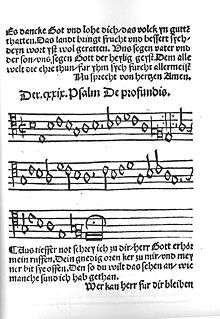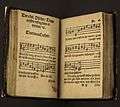Aus tiefer Not schrei ich zu dir
| "Aus tiefer Not schrei ich zu dir" | |
|---|---|
| Hymn by Martin Luther | |
 "Aus tieffer not schrey ich zu dir" in the Erfurt Enchiridion, 1524 | |
| English | From deep affliction I cry out to you |
| Text | by Martin Luther |
| Language | German |
| Published | 1524 |

"Aus tiefer Not schrei ich zu dir" (From deep affliction I cry out to you), originally "Aus tieffer not schrey ich zu dir", later also "Aus tiefer Noth schrei' ich zu dir", is a Lutheran hymn of 1524, with words written by Martin Luther as a paraphrase of Psalm 130. It was first published in 1524 as one of eight songs in the first Lutheran hymnal, the Achtliederbuch, which contained four songs by Luther, three by Paul Speratus, and one by Justus Jonas, and also appeared the same year in the Erfurt Enchiridion. It is part of many hymnals, also in translations. The text inspired vocal and organ music from the Renaissance to contemporary, including composers such as Johann Sebastian Bach, who based a chorale cantata on it, Felix Mendelssohn and Max Reger.
History and text
Luther paraphrased Psalm 130 as his first attempt to make the psalms accessible to Protestant church services in German. He transformed, likely in 1523, the Latin penitential psalm De profundis into a hymn. Luther sent it as a sample to encourage Protestant colleagues to write psalm-hymns for use in German worship. A version in four stanzas first appeared in 1524 in Nuremberg in Etlich Cristlich lider (Some Christian songs), also called Achtliederbuch, the first Lutheran hymnal. The same year it appeared in Erfurt in Eyn Enchiridion. A version in five stanzas, with the ideas of stanza 2 as two stanzas developing the theme of "grace alone" more fully, was first published in 1524 in Wittenberg in Eyn geystlich Gesangk Buchleyn. Scholars debate if the shorter version is actually Luther's, or reduced by an editor from the longer version.
The version in five stanzas, expressing essential Reformation doctrine, was designated as a regular component of several regional Lutheran liturgies. It was widely used at funerals, including Luther's own on 20 February 1546 in Halle.[1][2][3] Along with Erhart Hegenwalt's hymnic version of Psalm 51, Luther's hymn was also adopted for use with the fifth part of Luther's Small Catechism, concerning confession.[1]
Tune and hymnals
The chorale appeared first in the Achtliederbuch, supposed to be sung to the melody of "Es ist das Heil uns kommen her". In one of the Erfurt Enchiridia it is associated with the melody of Ach Gott, vom Himmel sieh darein".[4] Since, the text has been associated with two further tunes. One appeared in Eyn geystlich Gesangk Buchleyn, a collection by Johann Walter, the tune likely a work of Luther and Walter in collaboration. It is in Phrygian mode, preferred by Luther for texts of repentance, such as also "Ach Gott, vom Himmel sieh darein". Its bar form, a stanza of seven lines, a repeated two-line "Stollen" followed by an "Abgesang", is influenced by the Meistersinger. The second melody probably existed in the 15th century and was modified by Wolfgang Dachstein, published in Teütsch Kirchen amt (Part 1) Straßburg in 1525.[5] The chorale is part of many hymnals,[6] also in translations[2] such as Out of the depths I cry to Thee by Catherine Winkwort in 1861[7] and Isaac Stolzfus in 1998.[8]
Musical settings
Organ settings
Hans Kotter (c. 1480 – 1541) composed the "earliest extant organ setting of a Protestant chorale", an intabulation. Bach set the chorale twice in his Clavier-Übung III,[5] considered by Philipp Spitta in 1873 as "the crowning point of his work". Felix Mendelssohn based the third of his Organ Sonatas, Op. 65, on the chorale.[5]
Organ preludes include works by Johann Pachelbel, Johann Heinrich Scheidemann, Friedrich Wilhelm Zachow, Franz Liszt, Henk Badings, and the third of Max Reger's Fifty-two Chorale Preludes, Op. 67, composed in 1902. Waldemar von Baußnern composed a Chorale fantasy in 1912. Jürg Baur composed in 1965 Aus tiefer Not, Chorale Partita for organ.[5]
Christian Geist wrote an organ prelude on the second melody.
Vocal settings
Melchior Franck composed an expressive four-part setting. Michael Praetorius arranged the chorale for eight voices, one of the 1200 arrangements of Lutheran chorales in his Musae Sioniae. Johann Sebastian Bach used the complete chorale as the base for his chorale cantata Aus tiefer Not schrei ich zu dir, BWV 38, composed in Leipzig for the 21st Sunday after Trinity on 19 October 1724. Georg Friedrich Handel quoted the characteristic intervals from the beginning of the chorale's first tune several times at the end of the last aria of his oratorio Messiah, If God be for us, leading into the final chorus Worthy is the Lamb.
See also
| Wikimedia Commons has media related to Aus tiefer Not schrei ich zu dir. |
References
| German Wikisource has original text related to this article: |
- 1 2 Robin A. Leaver, "Luther's Catechism Hymns: 5. Baptism." Lutheran Quarterly 1998 12(2): 160–169, 170–180.
- 1 2 John Julian (1907). "Texts " Aus tiefer Not schrei ich zu dir". Dictionary of Hymnology. Retrieved 6 July 2011.
- ↑ "Aus tiefer Not schrei ich zu dir (Psalm 130) / Text and Translation of Chorale". bach-cantatas.com. 2006. Retrieved 6 July 2011.
- ↑ Raymond F. Glover (1994). The Hymnal 1982 companion, Volume 3. Church Publishing, Inc. Retrieved 5 August 2011.
- 1 2 3 4 "Chorale Melodies used in Bach's Vocal Works / Aus tiefer Not schrei ich zu dir (I) / Aus tiefer Not schrei ich zu dir (II)". bach-cantatas.com. 2006. Retrieved 6 July 2011.
- ↑ "Aus tiefer Not schrei ich zu dir". Dictionary of Hymnology. 2011. Retrieved 6 July 2011.
- ↑ Catherine Winkwort (1861). "Aus tiefer Not schrei ich zu dir". Dictionary of Hymnology. Archived from the original on 15 March 2012. Retrieved 6 July 2011.
- ↑ As published in the Amish 'Hymn Translations, German to English, from Ausbund and Lieder Buch, p. 10, Aylmer, Ontario: Isaac Stolzfus, 1998.
